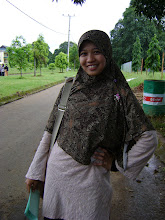10% dari apa yang kita baca
20% dari apa yang kita dengar
30% dari pa yang kita lihat
50% dari apa yang kita lihat dan dengar
70% dari apa yang kita katakan
90% dari apa yang kita katakan dan lakukan
Ketua Assembly for the Protection of Hijab, Abeer Pharaon lewat situs Islamonline bulan Juli kemarin menyerukan umat Muslim se-dunia untuk menjadikan Hari Jilbab Internasional yang jatuh setiap tanggal 4 September sebagai hari solidaritas untuk mengenang Marwa Al-Sharbini, seorang muslimah asal Mesir yang dibunuh oleh seorang pemuda Jerman keturunan Rusia di ruang sidang kota Dresden, Jerman awal Juli lalu.
Abeer mengatakan, Marwa Al-Sharbini adalah seorang martir bagi perjuangan muslimah yang mempertahankan jilbabnya. "Ia menjadi korban Islamofobia, yang masih dialami banyak Muslim di Eropa. Kematian Marwa layak untuk diperingati dan dijadikan sebagai Hari Hijab Sedunia," kata Abeer.
Jilbab memang masih menjadi hal yang menakutkan bagi sebagian orang. Bukan hanya di negara-negara Barat yang mayoritas penduduknya non-Muslim, bahkan di negara-negara yang penduduknya mayoritas Muslim seperti Indonesia. Bukti bahwa jilbab masih belum sepenuhnya mendapat tempat di negeri ini salah satu contohnya, masih banyak rumah-rumah sakit di negeri ini yang memberlakukan larang berjilbab terutama bagi tenaga perawatnya dan masalah ini masih belum menjadi perhatian para pemimpin di negeri ini yang seharusnya memberikan perlindungan terhadap hak-hak sipil seluruh warga negaranya.
Tapi itulah faktanya, jika di negeri Muslim seperti Indonesia saja jilbab masih menjadi hal yang menakutkan, bukan hal yang mengherankan jika banyak muslimah berjilbab di negeri-negeri non-Muslim yang mengalami diskriminasi, pelecehan dan penghinaan hanya karena mengenakan jilbab. Bahkan di beberapa negara, jilbab terang-terangan dilarang. Itulah sebabnya mengapa ada Hari Solidaritas Jilbab Internasional, karena banyak muslimah yang masih harus memperjuangkan hak-haknya untuk menjalankan perintah agamanya dalam hal ini perintah mengenakan jilbab.
Berawal Dari Inggris
Bulan Juli tahun 2004, tokoh-tokoh Muslim di seluruh Eropa berkumpul di kota London, Inggris. Mereka menggelar konferensi mendukung jilbab, sebagai reaksi atas keputusan pemerintah Prancis yang menyatakan melarang jilbab di institusi-institusi pendidikan dan institusi publik.
Konferensi dibuka oleh walikota London, Ken Livingstone dan dihadiri oleh 300 delegasi, mewakili 102 organisasi-organisasi Inggris dan internasional. Hadir pula dalam konferensi itu tokoh cendekiawan Muslim Sheikh Yusuf Al-Qaradawi dan Profesor Tariq Ramadan.
Dari hasil konferensi itu terbentuklah Assembly for the Protection of Hijab (Majelis untuk Perlindungan Jilbab) dan seluruh peserta mendeklarasikan tanggal 4 September sebagai International Hijab Solidarity Day (Hari Solidaritas Jilbab Internasional). Dalam konferensi itu, para peserta merancang berbagai rencana aksi untuk membela hak kaum perempuan Muslim untuk mempertahankan busana muslim mereka.
“Kampanye ini bukan hanya untuk wanita Muslim semata. Aksi ini ditujukan bagi siapa saja yang percaya bahwa merupakan hak seorang wanita Muslim untuk bisa mengenakan jilbabnya tanpa perlakuan diskriminatif dari masyarakat maupun pemerintahnya,” kata Koordinator Pro-Hijab, Abeer Pharaon ketika itu.
Sementara itu, Livinstone-walikota London yang dikenal dekat dengan komunitas Muslim di Inggris-dalam pernyataannya mengatakan, “Jika kami membiarkan serangan terhadap Islam terjadi, saya tahu siapa yang akan menjadi sasaran tembak dan korban berikutnya,” tukasnya.
Sejak itulah, setiap tanggal 4 September, organisasi-organisasi dan umat Islam, terutama muslimah yang tinggal di negara-negara non-Muslim menggelar Hari Solidaritas Jilbab Internasional. Meski gaungnya tidak terlalu menggema sampai ke negeri-negeri Muslim lainnya, termasuk Indonesia.
Padahal setelah kasus Marwa Al-Sharbini, kasus-kasus larangan jilbab masih terjadi di mana-mana. Beberapa negara bagian di Jerman sudah memberlakukan larang jilbab bagi para siswa sekolah, Mahkamah Agung di negara bagian Michigan AS, baru-baru ini mengabulkan permohonan pengadilan-pengadilan dibawahnya yang melarang muslimah berjilbab masuk ke ruang sidang, belum lama ini, seorang muslimah Selandia baru menggugat seorang hakim di Negeri Kiwi itu yang melarangnya masuk ke ruang sidang hanya karena ia berjilbab, bahkan di negara Turki yang pernah menjadi pusat kekhalifahan Islam, jilbab juga dilarang di institusi-institusi pendidikan terutama di universitas.
Tak ada alasan yang masuk akal atas semua larangan jilbab, kecuali karena fobia terhadap Islam dan arogansi budaya. Tapi dalam Islam, jilbab bukan semata-mata simbol agama tapi perintah yang diturunkan Allah Swt terhadap para muslimah untuk memuliakan kaum perempuan. (ln/berbagai sumber)
This section has been taken from materials authored by the Social Science Information Gateway (SOSIG) training team. For further information see:
Assalamu'alaykum!!!
kenalan dong......!aku Aisyah,skarang masih kuliah di Universitas Islam Negeri (UIN) Makassar jurusan matematika sains'06.Awalnya saya takut ambil jurusan ini coz pelajaran yang saya takuti sejak kecil adalah MATEMATIKA. Tapi.......skarang saya sadar bahwa selama ini pemikiran saya salah justru setelah kuliah saya menjadi sangat suka belajar MATH. So, buat temen2 tidak usah takut berhadapan dengan matematika coz banyak hal2 yang tak terduga yang akan dapatkan disini.
Jadi.......Mulai skarang camkan dalam pikiran kita bahwa "I LOVE MATH COZ MATH IS MY LIFE"
OK, I think thats all.......The next time will be continued.
C......U.....
Pengen membuat kayak gini..?
Lanjuuut >>
Status Yahoo Mesengger
Pengen membuat kayak gini..?
Lanjuuut >>
listrik ma telpon
Pengen membuat kayak gini..?Lanjuuut >>
kurs dollar
Pengen membuat kayak gini..? Lanjuuut >>

©2008. All rights Reserved